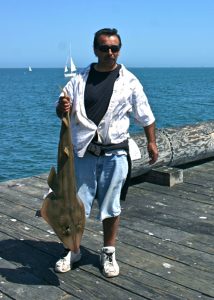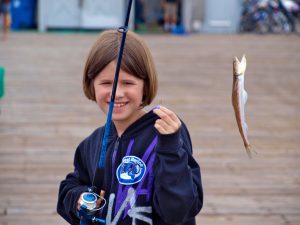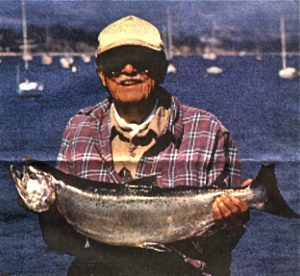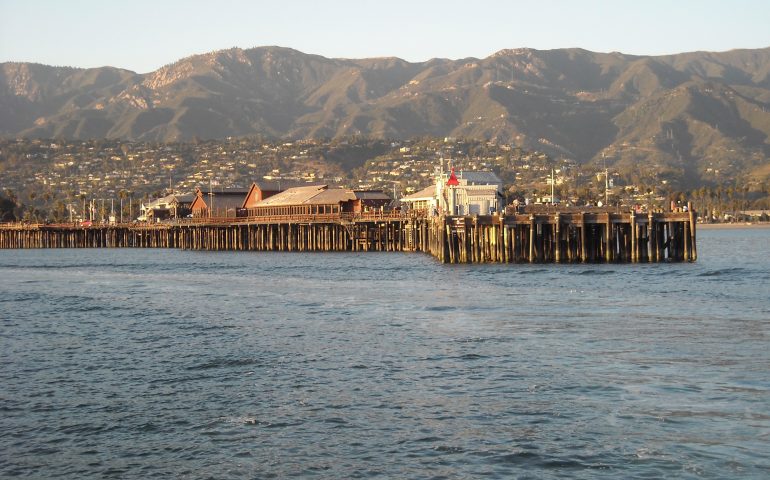The third approach, seemingly used by less and less people, is the old, tried-and-true approach to fishing the pilings and under the wharf for perch and bass. For this all you need is a light action rig, a couple of size 8-4 hooks, and a one-ounce torpedo sinker. Use seaworms—pile worms, bloodworms, and lugworms—fresh mussel, small ghost shrimp, or small pieces of market shrimp and fish the vertical length of the pilings as well as the area next to the base of the piling. Old time perchers, and I’m old enough to be one, would target big pileperch in the upper portions of the water, blackperch (buttermouth), rubberlip and rainbow seaperch down near the bottom next to the piling.
Those three techniques are the primary methods but there are lots of variations, especially when the live bait isn’t available. For the halibut, cut or whole anchovies can be used, either Carolina-style of with a high/low rig. Most people simply cast it out and wait, better is to cast out and retrieve slowly much as you would do with a lure. If the wharf isn’t crowded, troll (walk slowly) along the edge of the pilings; often the halibut like to hang in depressions between pilings. Lures will also work, with swim baits—Big Hammer, Fish Trap, etc. being the most commonly used. Am told by Pete Wolf, the local producer of the Big Hammer lures that the favorites for halibut in these waters are the anchovy, smelt and rainbow trout patterns. I understand the anchovy and smelt patterns, but come on, rainbow trout? Are some steelhead secretly hanging out under the wharf?
For sharks, guitarfish and bat rays use a bloody piece of mackerel or a decent-sized piece of squid and let the bait sit on the bottom. The sharks like the mackerel best, the rays like the squid (and some people put a live fish inside a hollowed out squid body for smell and movement). For the large bat rays use heavy tackle and be prepared; several bat rays weighing over 100 pounds have been landed here. Somewhat lighter gear is appropriate for most sharks but still have a net to bring the fish up to the pier. Am told by a regular who should know that about once or twice a year the pier gets a really heavy dose of mackerel and often during those times the thresher sharks follow the mackerel in. During such times a live mackerel put on a Carolina-rig or slid down a line on a sliding leader will hook the big-tailed sharks.

A relatively small shovel nose shark (guitarfish)
When the schools of larger mackerel move into the wharf area you may want to try something different than a bait rig. The bait rigs will work but sooner or later you’ll get three or more on a line and wind up with a tangled mess that either (1) means taking too much time to unravel the line or (2) cannot be untangled meaning the loss of a $3-4 rig. Better is simply to attach a couple size 4-2 hooks to the line, bait each with a strip of squid or piece of mackerel, cast out and begin a slow retrieve. If the macs are around they will find your bait. If the macs are skittish you may need to tie a single hook to the end of the line, attach a small split shot sinker a couple of feet up the line, and bait with a strip of squid or a piece of mackerel. Sometimes, when the macs are hanging mid-depth, you might also want to try a float; set it so the hooks and bait are 6-8 feet under the surface of the water. At night you can attach a glow stick near your bait and this will also improve your chances on the macs.
Small spoons will also work for the mackerel and in late fall the macs may be joined by barracuda (especially at night). When the ‘cuda are around a Kastmaster or Krocodile often proves deadly.
Although not as common as in the ‘60s and ‘70s, and rarely ever seen in the numbers common in those years, bonito have also begun to occasionally make a showing. For the bonito try a Cast-a-Bubble with a feather, shiny spoons like Kastmasters and Krocodiles, Snapper Zappers or MegaBaits. The boneheads will also fall for a lively sardine if they’re available.
As always you can also just cast out a baited high/low or Carolina rig and sit and wait. Cut bait most typically yields white croaker, thornback rays, small sharks and a variety of small perch and flatfish.
You may also want to try the fish well out near the end of the pier (and I almost always give it a try). The small, rectangular spot will often yield an unending number of small perch, primarily shiners, even when other areas are seeing few fish (and the shiners are good bait for halibut). Do though be careful of what you keep! Young, undersized kelp bass are very common here, as are a number of different juvenile rockfish (including kelp rockfish, grass rockfish, and olive rockfish—Johnny bass). While you can legally keep the young rockfish, you cannot keep the small kelp bass.
Although a monkeyface eel (prickleback) was taken on a squid-tipped Sabiki in May 2013, don’t expect to head out to the wharf on a monkeyface expedition, they are considered rare south of Point Conception. Be sure that you know how to identify the different species.
As mentioned, the inshore area is almost impossible to fish although a small area is available near the Sea Center. Water here is typically shallow and will yield some barred surfperch, yellowfin croaker, shovelnose guitarfish, thornback rays and a few white croaker and walleye surfperch. Try sand crabs, bloodworms, or fresh mussels if you want the larger perch, croakers and corbina. Try squid or bloody pieces of mackerel if you want sharks or rays and for some reason quite a few small bat rays are taken from the pier (as well as some really big ones). I don’t know why but local anglers often call the small baby bat rays monkeyface rays (and you should always return them to the water).
This area will also yield up halibut, especially when the grunion are doing their spawning routine. However, I have also been told it can be a mixed story at times when the grunion are present. Sometimes schools of dolphins will also follow the grunion into the shallow, inshore waters and unfortunately when they do, they put a damper on the fishing for croakers, corbina and barred surfperch.
Nevertheless this is still probably the best area for the flatties unless the local authorities are doing their (fairly regular) dredging operations. When dredging is taking place it disturbs and muddies up the inshore water and the baitfish and the halibut seem to be pushed further out into the deeper waters around the wharf.
I’ve also seen some large pileperch and rubberlip seaperch lurking near the pilings, especially where the wye section connects to the main part of the pier. As usual, these species are hard to hook. One local technique is to attach half of a mussel shell to the line with a paper clip. A couple of size 12 hooks on dropper lines are then inserted into the meat of the mussel. When the large perch suck up the meat they get hooked.

It looks like lizardfish were the catch of the day
In April of 2002 I had the chance to fish the wye section (behind the Sea Center and out of the wind) for a couple of evening hours with PierHead and Sinker, two of the esteemed PFIC Message Board regulars. Using some fresh mussels on size 6 hooks, I managed to land a couple of buttermouth perch (blackperch), a splittail perch (white seaperch), and something that I would have expected if I was fishing in San Francisco Bay—a bullhead (staghorn sculpin). All of the perch were taken when fishing directly under the pier and right up against the pilings; the sculpin hit my lone cast out to the deeper waters.
Sharks, by the way, do not seem to have the following here that some piers do in this area. However a number of large leopard sharks (to 5-feet-long) are normally caught each year from the mid-pier area out to the end. Add in some gray smoothhounds, an infrequent thresher shark, and even less common swell sharks and seven-gill sharks, and you have a nice mixture of sharks.
Also, always be prepared for the unexpected. On a short visit to the pier in July of 1994 I had experienced what can only be described as a poor fishing trip for myself—two small fish, a kelp bass and a jack mackerel. However, an old-timer stood proudly nearby, displaying a 29-inch, 11-pound silver salmon he had caught on the pier that afternoon. His name was Bill Schenk, he was 90 1/2 years young, and he had fished on the wharf nearly every day since 1969. He, of course, was a regular and one who had his own personal pier name, Sitting Bill, since there were four other regulars also with the name of Bill. It was the largest fish “Sitting Bill” had caught on the pier in 25 years. It was also his second salmon after an earlier 3-pounder in 1990. Using light trout-fishing tackle and a heavier than normal 8-pound line (because barracuda had been biting through his line) he had his hands full. However, his friend, Mike Katz, owner of the nearby tackle shop, heard his cries, ran out, and netted the fish. The day was considered a great success for Sitting Bill. Meeting him and getting the chance to talk with him made my visit a success. Another salmon, although not taken by “Sitting Bill,” was a fish taken in October of 2008.

Sitting Bill and his salmon
Unusual occurrences have included a good run of sole that took place in February and March of 1997. For a period of time no one seemed to be sure what the 12-14” fish really were. Some thought they were diamond turbot, some votes went to C-O turbots (Pleuronichthys coenosus), some went to honeyhead turbots (Pleuronichthys verticalis), and some votes were even cast for rock sole (Lepidopsetta billineata) or spotted turbot (Pleuronichthys ritteri). The fish turned out to be fantail sole (Xystreurys liolepis) but just about the time they were identified the run stopped.
In August of 2006 a giant (black) sea bass was caught and returned to the water (as required by law). In April 2016 a small barracuda was caught at the wharf which, according to informed sources, was the first seen in over a decade. Another small barracuda was caught in July of that year. Yellowtail, which once were a fairly common fish during warm-water years, are rarely seen today although a small yellowtail was taken in June of 2016 (a strong warm-water year).
Timing can also be critical. Several different times over the years I’ve heard of the “afternoon mackerel.” After a short run early in the morning, the mackerel would disappear and then, like clockwork, reappear between 3:30-4 p.m. in the afternoon. Evidently, this is most common in the summer months and does not happen every year. However, as a rule, the fishing is best in the morning and in the late afternoon-early evening.
Lastly, be willing to try different methods. In October of 2008 I was visiting Santa Barbara for a conference and knew that for several weeks anglers had been making good catches of both Pacific and Spanish mackerel. Although I would only be in town for a few days, and only able to fish for a few hours, I figured I could join in the fun on the mackerel.
Unfortunately, the winds picked up just a couple of days before I arrived and the mackerel bite turned off. Were the macs still there but not biting, or had the fish moved offshore? No one knew the answer. Nevertheless, I was going to be in town and I would give it a try.
A walk to the end of the wharf showed people continuing to toss out Sabikis for the mackerel (and other baitfish) but they simply were not hooking any fish. And though a few regulars had, somehow, somewhere, scrounged up some live bait, they were sitting somewhat dejectedly talking about how the fish “had” been biting.
Given that I was only going to be in the area for a couple of days I was willing to catch almost anything, it didn’t have to be mackerel or halibut. I simply wanted a little action. Given that I like to fish the piling areas I checked those first and quickly noticed that piling #135 had a much better growth of kelp around it than the other pilings; I would try it first. Using my normal high/low rigging, size 6 hooks, and pile worms for bait, I dropped the rig down into the water. Putting the rig about 8-12 feet down, right next to the piling and its kelp, resulted in almost immediate strikes. Dropping the rig to the bottom, in a small space between four closely spaced pilings, meant a little slower action but somewhat better fish. An hour and forty-five minutes produced 7 kelp bass, 4 senorita, 2 walleye surfperch, 1 white seaperch, and 3 topsmelt. A couple of casts away from the pier followed by a slow retrieve yielded little except for 2 shinerperch and 1 speckled sanddab.

Awesome write up! Thanks. We just caught a 36 inch halibut off the pier, 6/25/19. Email me for pics
I used to fish Stearns Wharf all the time when I was a kid back in the late 80s / early 90s. I remember it was usually always really good for mackerel, with bonito and barracuda showing up usually in Sept. and Oct. There were also times when truly monster size halibut would show up and hang around the pier for weeks at a time. Other than that the fishing there for other species wasn’t all that great, and the surf area was pretty lifeless, no doubt due to the little 6 inch waves, just an occasional thornback and a corbina might cruise by every once in a while.
[…] Fish available at the pier are the normal southern California species with halibut, mackerel, jacksmelt, white croaker (ronkie), sand bass, kelp bass (calico bass), scorpionfish (sculpin), various perch, bat rays, and shovelnose guitarfish (sand sharks) dominating the catch. via […]